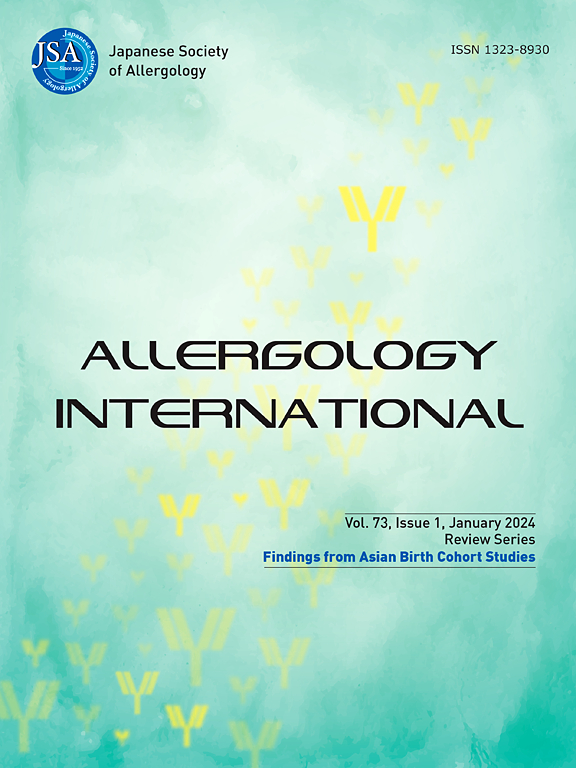Comprehensive review of pollen-food allergy syndrome: Pathogenesis, epidemiology, and treatment approaches
IF 6.2
2区 医学
Q1 ALLERGY
引用次数: 0
Abstract
Pollen-food allergy syndrome (PFAS) is caused by cross-reaction of a specific pollen antigen with the corresponding food allergen in sensitized individuals. The manifestations are usually limited to oral symptoms; however, sometimes, rhinitis, respiratory and skin symptoms, and anaphylactic shock may occur. In PFAS pathogenesis, when food containing protein antigens (pan-allergens) with high homology to pollen antigens is ingested, mast cells bound to pollen antigen-specific IgE distributed in the oral mucosa cross-react with the food antigen, causing a local type I allergic reaction. The prevalence of PFAS depends on the geographic conditions, such as the type and amount of pollen in the area. PFAS is prevalent in all regions owing to the wide variety of pollen antigens implicated in the disease, such as alder and grass pollen, even outside of the birch habitat area. Basic research on PFAS is expected to significantly contribute to elucidating the pathogenesis and development of therapeutic strategies for PFAS. Currently, effective treatment for patients with PFAS that allows safe consumption of raw foods is lacking, and avoiding the intake of causative foods is the basis of prevention. Furthermore, allergen immunotherapy for PFAS has not yet been established, but various attempts are underway to develop it into a novel treatment strategy. This review highlights the current research landscape on the pathophysiology, epidemiology, and clinical aspects of PFAS. We outline the research gaps that should be addressed to improve the outcomes of patients with PFAS.
花粉-食物过敏综合征综述:发病机制、流行病学和治疗方法。
花粉-食物过敏综合征(PFAS)是由过敏体质的人体内特定花粉抗原与相应食物过敏原发生交叉反应引起的。其表现通常仅限于口腔症状,但有时也会出现鼻炎、呼吸道和皮肤症状以及过敏性休克。在 PFAS 的发病机制中,当摄入含有与花粉抗原高度同源性的蛋白质抗原(泛过敏原)的食物时,与分布在口腔黏膜中的花粉抗原特异性 IgE 结合的肥大细胞会与食物抗原发生交叉反应,引起局部 I 型过敏反应。PFAS 的流行程度取决于地理条件,如该地区花粉的种类和数量。由于与该病有关的花粉抗原种类繁多,如桤木花粉和草花粉,因此 PFAS 在所有地区都很普遍,甚至在桦树栖息地以外的地区也是如此。有关 PFAS 的基础研究有望为阐明 PFAS 的发病机制和制定治疗策略做出重大贡献。目前,还缺乏针对 PFAS 患者的有效治疗方法,使其能够安全食用生食,而避免摄入致病食物是预防的基础。此外,针对 PFAS 的过敏原免疫疗法尚未确立,但人们正在进行各种尝试,以将其发展成一种新型治疗策略。本综述重点介绍了目前有关全氟辛烷磺酸的病理生理学、流行病学和临床方面的研究情况。我们概述了为改善 PFAS 患者的治疗效果而应填补的研究空白。
本文章由计算机程序翻译,如有差异,请以英文原文为准。
求助全文
约1分钟内获得全文
求助全文
来源期刊

Allergology International
ALLERGY-IMMUNOLOGY
CiteScore
12.60
自引率
5.90%
发文量
96
审稿时长
29 weeks
期刊介绍:
Allergology International is the official journal of the Japanese Society of Allergology and publishes original papers dealing with the etiology, diagnosis and treatment of allergic and related diseases. Papers may include the study of methods of controlling allergic reactions, human and animal models of hypersensitivity and other aspects of basic and applied clinical allergy in its broadest sense.
The Journal aims to encourage the international exchange of results and encourages authors from all countries to submit papers in the following three categories: Original Articles, Review Articles, and Letters to the Editor.
 求助内容:
求助内容: 应助结果提醒方式:
应助结果提醒方式:


